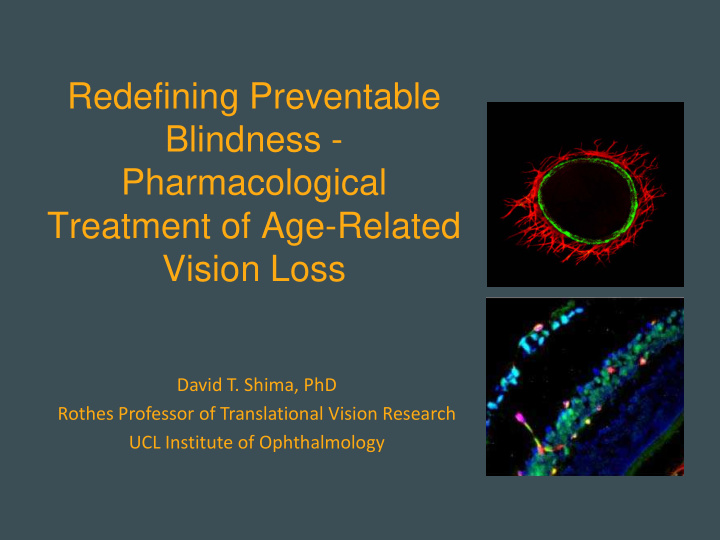



Redefining Preventable Blindness - Pharmacological Treatment of Age-Related Vision Loss David T. Shima, PhD Rothes Professor of Translational Vision Research UCL Institute of Ophthalmology
The urgency to develop treatments for vision loss: wet AMD
Advanced stages of AMD
Age-Related Macular Degeneration
Neovascular AMD and Diabetic Retinopathy • Leading causes of blindness in aging adults in developed world • Though distinct pathogenesis, AMD and DR both linked to abnormal growth and behaviour of blood vessels
Vascular Endothelial Growth Factor (VEGF) Angiogenic in vivo Vascular Endothelial Growth Factor Potent inducer of edema in the retina Vascular Permeability Factor
VEGF and oxygen levels
VEGF levels correlate with hypoxia and ischemia-induced iris neovascularization Anti-VEGF Ab Control Arch Ophthalmol 1996;114:66-71
Toppling of the Barriers to Developing Drugs for AMD • Late 1990s - Treatments mainly surgical or laser-based - Concept of repeat intravitreal injections was refuted - No Investors • 2000 Investment in Eyetech (Dotcom boom) • 2000 Genentech announce clinical development of Lucentis • 2002 $750M Eyetech deal with Pfizer • 2003 Genentech/Novartis deal
Progress for patients with wet AMD • Pegaptanib (Macugen) • Approved 2004 • Stabilize vision •Ranibizumab (Lucentis) • Approved 2006 • Reverse vision loss
Anti-VEGF in AMD Rosenfeld et al, NEJM 2006:355;1419 3
The Impact of Drug Development Source: Abbott Laboratories 2
Expectations for the Ophthalmic Drug Industry $21.0 Total = $19.3B $18.0 Diabetic $4.0 Retinopathy $15.0 Macular $5.8 $12.0 Degeneration Total = $8.6B $9.0 Anti-Inflamm Dry Eye $3.8 $2.8 Anti-Allergy $6.0 Antibiotics Total = $4.4B $2.9 $3.0 $2.5 $5.7 Glaucoma $2.9 $1.9 $0.0 2000 2005 2010 Source: S.G. Cowan/Braun and other industry sources
The challenges
1. The law of diminishing returns Rosenfeld et al, NEJM 2006:355;1419 3
2. Cost and Time: 14.2 Years To Develop a Drug 14.2 years DiMasi et al., J Health Economics 2003;22(2):151-185 8
3. Drug Approvals Are Not Keeping Pace With R&D Spending R&D expenditures adjusted for inflation Source: Tufts Center for Drug Development 2005 5
The Development Gauntlet 13 Compounds 13
4. Cost effectiveness a must
5. Safety challenge grows The ability to prevent death and prolong survival means survival is with co morbidity
Conclusions and Solutions? • Expectations are high, but drug development is costly and success rates are low • With the growing ageing population, cost effectiveness will play a major role in any success scenario • With the growing ageing population, co-morbidities, poly-pharmacy and safety concerns will be a challenge • Explore the landscape in ophthalmic drug development
Pharmacological treatment of AMD and DR • Anti-VEGF drugs (Macugen, Lucentis, Avastin) have improved vision or prevented legal blindness in many tens of thousands of AMD patients • Need to expand upon use in DR and vein occlusion • Need for drug delivery to enable AMD prevention approaches and chronic treatment of DR • 60% of wet AMD eyes see 20/50 or worse despite Lucentis • Need for combination and next generation treatments
Expanded use of VEGF antagonists for retinal disease Macugen Lucentis Avastin
Need for Advances in Drug Delivery for AMD and DR • Current drugs require 9-12 injections/year based on pivotal studies • Approx 5-6/yr in real world setting • Safety, inconvenience and workload issues • Diabetic retinopathy, prevention strategies for wet AMD and treatment of severe dry AMD require advanced formulation
VEGF antagonists and safety risks Potential for anti-VEGF therapeutic toxicity in humans • Thrombosis • Hemorrhage • Hypertension • Proteinuria • Neural effects
Drug Delivery Strategies • I-vation coil - Surmodics • Vitreal implants - Posurdex - Medidur
PLGA Microspheres
PLGA based commercial products
Target product profile • Duration of release enables reduction to < 2 injections/yr • Utilize components with known safety in ocular setting • Must be syringable through 27 gauge needle • Efficient load and low burst release
Reformulation to enable Prevention • In vitro sustained release from microparticles
Drug Delivery enables strategies aimed at prevention of advanced AMD
Geographic atrophy • Patients with central GA - ~1M people in EU - No treatments - 50% legally blind in 2 years
All the buzz about Complement • Complement pathway is involved in defense against microbes • Hypothesis is that unchecked, complement may damage our own tissues • Human genetic data have identified complement gene polymorphisms linked to increased risk for AMD (CFH, CFB, C3) • Risk is related to progression to advanced AMD - Both wet AMD and geographic atrophy • ~ 10 Complement antagonists in development for AMD
60% of patients treated with Lucentis still have disabling vision Need for combination and next generation therapies
By 2003, clinical data suggested treated lesions did not regress
Extending the rationale for targets in the neovasculature
Combination therapy: a scientific rationale Anti-pericyte or matrix Anti-endothelium (Lucentis) Pericytes Endothelial Cells
What about attacking the pericyte by blockade of PDGF-B? Lectin/SMA Control ( Day 20) Lectin/SMA Anti-PDGFB (Day 20)
E10030 (anti-PDGF-B) finished Phase 1 Pre-combination therapy Post-combination therapy Post-combination therapy 1 month 2 month 20/80 20/32 20/25 +21 Letters +27 Letters
Targeting the vessel • VEGF (OSI-Eyetech, Genentech, Regeneron) • PDGF-B (Ophthotech) • Delta-4 (Genentech, Regeneron) • α 5 β 1 integrin (Jerini Ophthalmic)
The integrin antagonist JSM6427 is entering Phase 2 clinical trials for Wet AMD d7 d14 d21 d28 Vehicle JSM6427
Future • Anti-VEGFs have paved the way for the next generation of treatments for age-related vision loss • Challenges are significant - Cost, Safety - Clinical Trials - Avastin • Enabling technologies are critical - Better biomarkers - Diagnostics - Drug Delivery
UCL Institute of Ophthalmology partners • NIHR Biomedical Research Centre at Moorfields • MRC • Jerini Ophthalmic • GSK
Recommend
More recommend